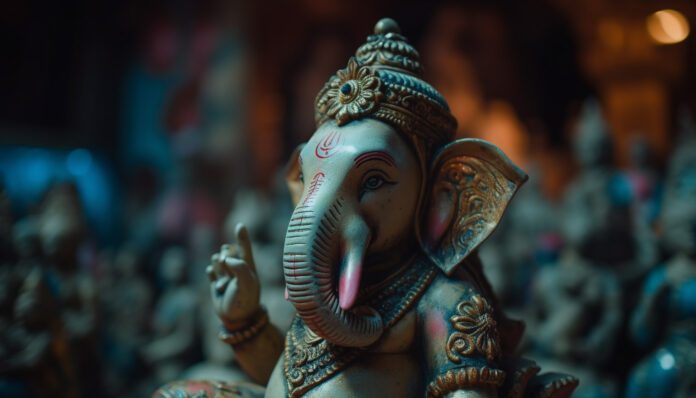India is a land of diverse cultures and traditions, and one of the most vibrant and widely celebrated festivals in the country is the Ganesh Festival, also known as Ganesh Chaturthi. This joyous occasion marks the birth of Lord Ganesha, the beloved elephant-headed god of wisdom, prosperity, and good fortune. The festival is celebrated with immense enthusiasm and grandeur throughout India, especially in the states of Maharashtra, Gujarat, and Karnataka.
The Legend of Lord Ganesha:
Before delving into the details of the festival, let’s explore the legend behind Lord Ganesha. According to Hindu mythology, Ganesha is the son of Lord Shiva and Goddess Parvati. The story goes that Parvati created Ganesha from sandalwood paste and breathed life into him to guard her privacy while she bathed. When Lord Shiva returned and found Ganesha blocking his way, a fierce battle ensued, resulting in Ganesha’s head being severed.
To appease Parvati’s grief, Lord Shiva replaced Ganesha’s head with that of an elephant, giving him a unique appearance. This act transformed Ganesha into a deity widely revered as the remover of obstacles and the harbinger of good fortune.
The Preparations:
The Ganesh Festival typically falls in the Hindu month of Bhadrapada, which usually corresponds to August or September in the Gregorian calendar. Weeks before the festival, preparations begin with great enthusiasm. Artisans create exquisite clay idols of Lord Ganesha in various sizes, from small household idols to massive community statues.
Bringing Ganesha Home:
On the day of Ganesh Chaturthi, devotees bring the idol of Lord Ganesha into their homes with great reverence. The idol is placed on an altar, beautifully decorated with flowers, garlands, and incense. Families offer sweets, fruits, and other delicacies to the deity as a gesture of welcome.
Public Celebrations:
While household celebrations are heartfelt and intimate, the true spectacle of the Ganesh Festival can be witnessed in the grand public celebrations. In cities like Mumbai and Pune, massive Ganesha idols are installed in temporary pandals (decorated tents) in various neighborhoods. These idols often reach staggering heights and are adorned with intricate decorations.
The festival is marked by processions that wind through the streets, accompanied by dancing, drumming, and singing. Devotees join these processions, carrying the idol of Lord Ganesha, and seek his blessings. The atmosphere is electric, and the sense of unity and devotion is palpable.
Visarjan (Immersion):
The Ganesh Festival culminates on Anant Chaturdashi, which is the tenth day of the festival. On this day, devotees bid farewell to Lord Ganesha in a ritual known as “visarjan.” The idols are carried in processions once again, but this time they are immersed in rivers, lakes, or the sea. The act of immersion symbolizes the cycle of creation and dissolution and the belief in Lord Ganesha’s return the following year.
Eco-Friendly Celebrations:
In recent years, there has been a growing awareness of the environmental impact of the Ganesh Festival. Many communities and individuals have shifted towards using eco-friendly idols made from clay and natural colors to minimize pollution of water bodies during immersion. This shift reflects a broader trend of environmental consciousness in Indian festivals.

Unity in Diversity:
The Ganesh Festival is a shining example of India’s cultural diversity and unity. People from all walks of life, regardless of caste, creed, or religion, come together to celebrate this beloved deity. It promotes a sense of community and strengthens the social fabric of the country.
Bal Gangadhar Tilak’s Contribution:
Bal Gangadhar Tilak, also known as Lokmanya Tilak, recognized the potential of Ganesh Chaturthi as a means to unite and inspire the masses during India’s struggle for independence from British colonial rule in the late 19th century.
Tilak believed that harnessing the religious and cultural fervor of Ganesh Chaturthi could serve as a platform for bringing people together, transcending the boundaries of caste and creed. In 1893, he initiated the idea of public celebrations of Ganesh Chaturthi in Pune, Maharashtra, with the aim of fostering unity and instilling a sense of pride in Indian culture and traditions.
Transforming a Religious Festival: Under Tilak’s guidance, Ganesh Chaturthi evolved from a private household ritual into a grand public spectacle. He encouraged the installation of large Ganesh idols in pandals (temporary structures) across the city. These idols, often reaching impressive heights, became the centerpieces of the festivities. They were adorned with ornate decorations and illuminated by vibrant lights.
Public processions, music, dance, and cultural performances became integral to the celebration. The streets of Pune came alive with the vibrant colors and the collective spirit of the people. The festival provided a platform for political discourse, promoting ideas of freedom and self-rule among the masses.
Unity and Nationalism:
Bal Gangadhar Tilak’s vision of Ganesh Chaturthi as a vehicle for social reform and political awakening extended beyond Maharashtra. The festival’s popularity spread to other parts of India, becoming a symbol of unity and nationalism. It encouraged people to come together, transcending their differences, in the pursuit of a common goal: independence from British rule.
Modern Ganesh Chaturthi Celebrations: Today, Ganesh Chaturthi continues to be celebrated with immense enthusiasm and grandeur across India, especially in Maharashtra. Bal Gangadhar Tilak’s legacy lives on in the form of elaborate processions, eco-friendly idols, and community gatherings.
Ganesh Chaturthi, with its rich history and cultural significance, is a testament to India’s diversity and unity. Thanks to Bal Gangadhar Tilak’s vision, the festival has not only remained a religious observance but has also become a symbol of collective strength, patriotism, and cultural pride. Bal Gangadhar Tilak’s contribution to this grand celebration will always be remembered as a pivotal moment in India’s struggle for freedom and as a unifying force that continues to inspire generations.


